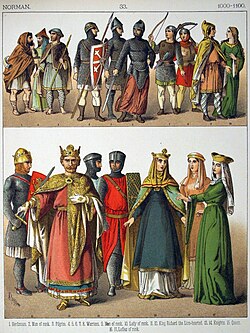
Back أنغلو-نورمان Arabic Anglonormannen German Anglonormandos Spanish Baronnage anglo-normand French Tiarnas Angla-Normannach Irish ממלכת אנגליה הנורמנית HE Anglonormani Croatian Anglo-Norman ID Anglo-normanni Italian ანგლო-ნორმანული ინგლისი Georgian
This article needs additional citations for verification. (January 2025) |
 Examples of Anglo-Norman elite | |
| Languages | |
|---|---|
| Religion | |
| Christianity | |
| Related ethnic groups | |
| History of England |
|---|
 |
|
|
The Anglo-Normans (Norman: Anglo-Normaunds, Old English: Engel-Norðmandisca) were the medieval ruling class in the Kingdom of England following the Norman Conquest. They were primarily a combination of Normans, Bretons, Flemings, Frenchmen, Anglo-Saxons and Celtic Britons.
After the conquest the victorious Normans formed a ruling class in England, distinct from (although intermarrying with) the native Anglo-Saxon and Celtic populations. Over time, their language evolved from the continental Old Norman to the distinct Anglo-Norman language. Anglo-Normans quickly established control over all of England, as well as parts of Wales (the Welsh-Normans). After 1130, parts of southern and eastern Scotland came under Anglo-Norman rule (the Scots-Normans), in return for their support of David I's conquest. The Anglo-Norman invasion of Ireland from 1169 saw Anglo-Normans and Cambro-Normans conquer swaths of Ireland, becoming the Irish-Normans.
The composite expression regno Norman-Anglorum for the Anglo-Norman kingdom that comprises Normandy and England appears contemporaneously only in the Hyde Chronicle.[2]
- ^ The English And The Normans: Ethnic Hostility, Assimilation, and Identity 1066 - c. 1220, Oxford University Press, U.S.A. (3 Oct. 2002) p. 146
- ^ C. Warren Hollister, Henry I (Yale English Monarchs) 2001:15.